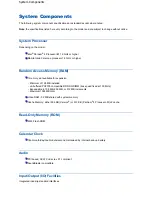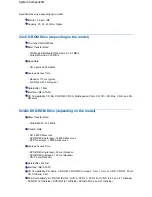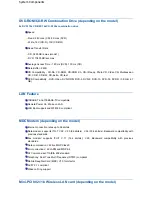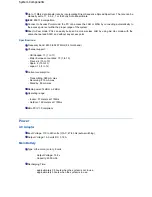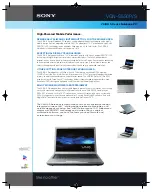
These Frequently Asked Questions are common to a wide range of notebooks; please note that some may
not be relevant to your Versa.
Wireless Communication Protocols
Note
: your Versa may feature Wireless LAN 802.11b and/or Bluetooth support. Please refer to the
'System
Components'
section for the detailed specifications of your wireless card (if applicable).
Basically, wireless communication can be divided in three categories:
Wireless Personal Area Network (WPAN)
- connecting personal wireless products to your
computer, for instance synchronising a personal digital assistant (PDA) to a personal computer. This
can be achieved via the Bluetooth standard. The range of this connectivity is about 10 meters in ideal
conditions.
Wireless Local Area Network (WLAN)
–
a wireless connection to an office or campus. There is still
an existing Ethernet network, but the connection to the PC is wireless. This way, a person can take a
portable PC around an office or campus while remaining connected to the network. The range of this
wireless connectivity will be about 100 meters in a place with buildings and walls. This can be
achieved via the 802.11b standard.
Wireless Wide Area Network (WWAN)
–
access to the Internet/Intranet on the road or elsewhere,
away from an office or campus. This type of wireless connection offers slower data rates but broad
availability. This can be achieved via the third generation of mobile phones (such as GPRS and
UMTS).
Bluetooth
TM
What is Bluetooth?
Bluetooth is a high-speed wireless (maximum 723 Kb/s) link system that is designed to work with portable
equipment such as laptops, PDAs, cell phones or wired telephone access points.
How does it work?
Bluetooth operates in the unlicensed Industrial, Scientific and Medical (ISM) band at 2.45GHz, which is
globally available for products. The link constantly switches channel to avoid interference, roughly about 1600
times a second through 79 frequency bands (83MHz bandwidth). All devices on a piconet (2 or more
Bluetooth units sharing a channel) are synchronised and controlled by a master device to prevent
simultaneous operation on the same frequency. Any device can be master, and is elected dynamically when
the link starts up.
802.11b
What is 802.11b?
The Institute of Electrical and Electronics Engineers (IEEE) ratified the 802.11b standard (also known as
802.11 High Rate) for wireless LAN transmissions of up to 11 Mbps (5.5 and 11 Mb/s).
How does it work?
This standard defines two modes:
in infrastructure mode, the wireless network consists of at least one access point connected to the
wired network infrastructure and a set of wireless end stations. This configuration is called a Basic
Service Set (BSS). An Extended Service Set (ESS) is a set of two or more BSSs.
in Ad hoc mode, also called peer-to-peer mode or an Independent Basic Service Set (IBSS), a set of
802.11 wireless stations communicate directly with one another without using an access point or any
connection to a wired network.
Frequently Asked Questions
Summary of Contents for Versa 2730M
Page 1: ...Versa User s Guide Versa User s Guide ...
Page 15: ...Copyright Copyright ...
Page 17: ...Introducing Your Versa Getting to Know your Versa ...
Page 19: ...Around the Front of the System Around the Front of the System ...
Page 25: ...Around the Back of the System Around the Back of the System ...
Page 27: ...Around the Left Side of the System Around the Left Side of the System ...
Page 29: ...Around the Right Side of the System Around the Right Side of the System ...
Page 31: ...Around the Bottom of the System Around the Bottom of the System ...

